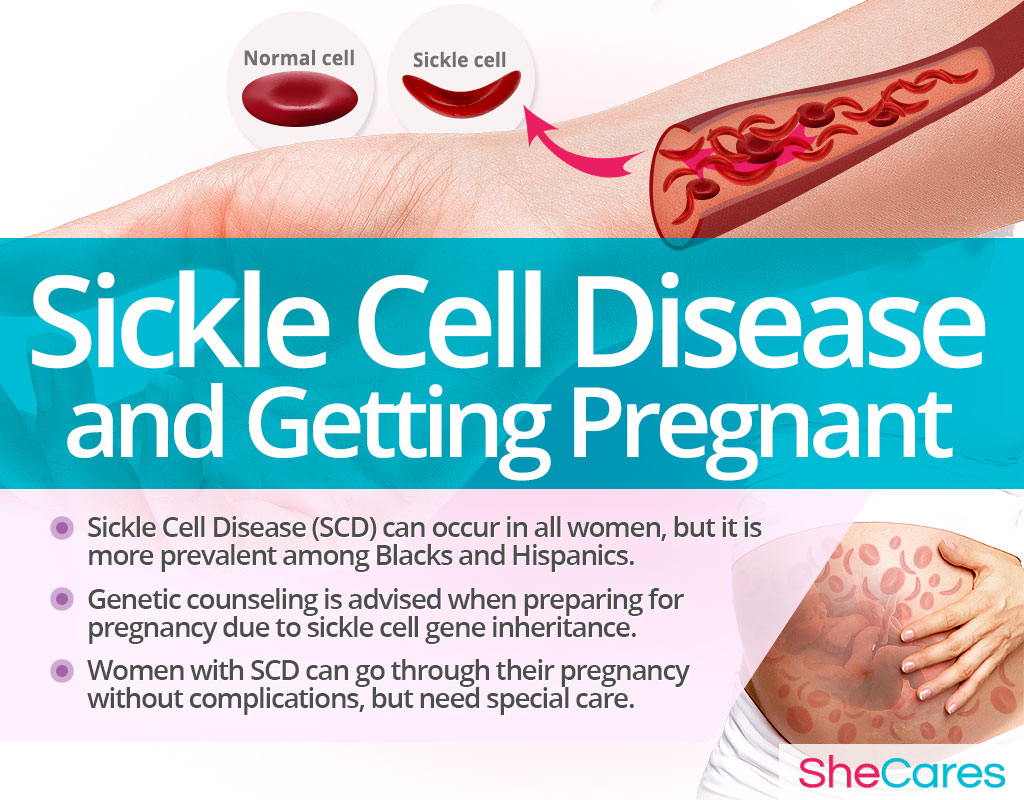Brief Overview of Sickle Cell Disease
Sickle cell disease (SCD) is a group of heritable conditions passed on to a child when both parents contribute a gene. It is characterized by an abnormally shaped hemoglobin, which is a protein found in the red blood cells (RBC) and responsible for carrying oxygen throughout the body. Its unusual C-letter shape prevents RBC from moving smoothly through the veins and arteries, bringing about numerous symptoms and risks.
Sickle cell trait (SCT), however, occurs when only one parent passes a gene, resulting in a child being a carrier without developing the disease itself.
There are a few recognized types of SCD, such as sickle cell anemia (SS), sickle hemoglobin-D disease, or sickle beta-plus thalassemia (SB), none of which can be cured.
Sickle Cell Gene Inheritance
There are five possible scenarios of sickle cell gene inheritance:
When both parents have sickle cell disease, then each child will have the disease as well.
When only one parent has sickle cell disease, then each child will have sickle cell trait.
- When both parents have sickle cell trait, then each child has a:
- 50% chance to have sickle cell trait
- 25% chance to have sickle cell disease
25% chance to have normal hemoglobin.
- When only one parent has sickle cell trait, then each child has a:
- 50% chance to have normal hemoglobin
50% chance to have sickle cell trait.
- When one parent has sickle cell trait and the other has sickle cell disease, then each child has a:
- 50% chance to have sickle cell trait
50% chance to have sickle cell disease
There are prenatal tests to check whether a baby inherited a gene for sickle cell disease or trait.
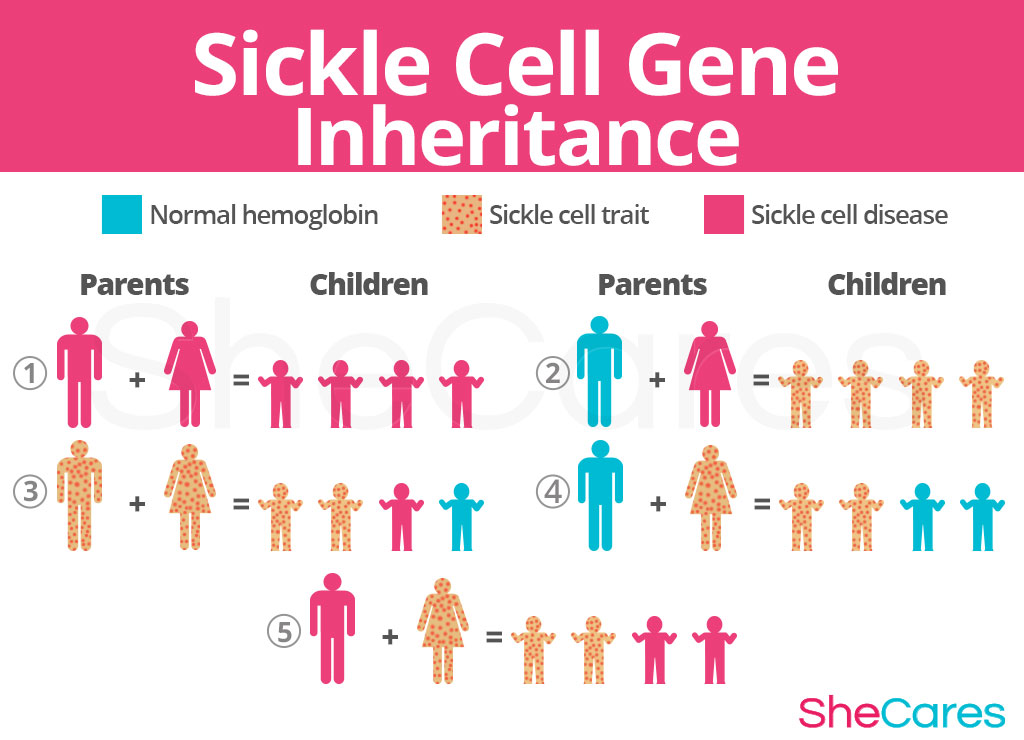
Effects of Sickle Cell Disease on Pregnancy
The majority of negative effects are seen among women with sickle cell disease, but those carrying a trait have to take their condition into consideration when preparing for pregnancy due to gene inheritance.
Effects of Sickle Cell Disease on Fertility
Most women with sickle cell disease can get pregnant, but the condition can potentially affect a woman's fertility due to:
Ovarian dysfunction due to diminished blood and oxygen supply to vital organs might disturb the production of key reproductive hormones. This, in turn, can deregulate menstrual cycle and increase the chances of infertility.
Transfusion-induced iron overload can lead to an imbalance in FSH and LH levels and hypothalamic-pituitary dysfunction, resulting in infertility.
Premature ovarian failure, which brings about early menopause and leads to infertility, might occur after bone marrow transplant in some women.
Effects of Sickle Cell Disease on the Mother and Baby
During pregnancy, the episodes of sickle cell disease pain - called crises - tend to increase in their frequency and severity. Mothers are put at an increased risk of stroke, pulmonary hypertension, anemia, infections, and multi-organ dysfunction.
SCD might also affect the developing baby due to an insufficient oxygen supply, resulting in severe anemia, poor fetal growth, or low birth-weight.
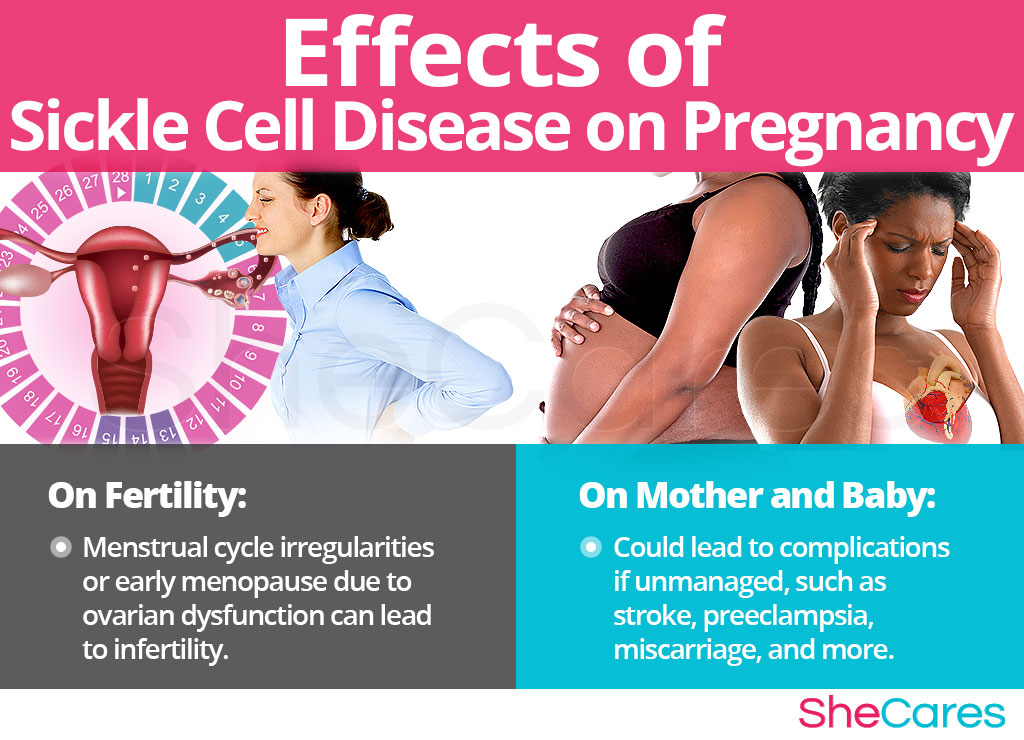
Risks and Complications
Severely uncontrolled sickle cell disease might result in preeclampsia, preterm labor, miscarriage, or stillbirth.
Action Plan
Control Sickle Cell Disease before Pregnancy
Your goal during preconception is to improve your lifestyle habits to decrease the occurrence of crises. Consider the following approaches:
Healthy Diet
Many women with SCD have nutritional deficiencies and poor circulation. Their increased calorie and micronutrient need can be satisfied with the foods that are rich in the following:
Folates, such as spinach or kale
Calcium, such as yogurt or cheese
Vitamin C, such as kiwi or lemon
Phytoestrogens, such as asparagus or garlic
Antioxidants, like grapes or berries
Lean proteins, such as eggs or chicken
Whole grains, seeds, and nuts, like buckwheat, flax, and walnuts
Drink six to eight glasses of water a day, to support circulation and decrease the frequency of crises.
Vitamins and Supplements
Prenatal vitamins, especially folic acid or zinc, are a must during pre-conception and are necessary for women with sickle cell to make new red blood cells. Read more about prenatal vitamins.
Hormone-regulating supplements, like Macafem, can resolve your hormonal imbalance, thus restoring menstruation, decreasing painful menses, and increasing your conception chances.
Fish oil supplements, particularly those high in EPA and DHA, can relieve painful flares characteristic of sickle cell disease.
B6 and B12 vitamin supplements have been shown to provide protection from tissue damage common to sickle cell disease, especially when taken with vitamin C and folic acid.
L-arginine and L-carnitine supplements might be beneficial for those SCD women who suffer from pulmonary hypertension and heart problems.
Adequate Exercise
Opt for regular, moderate-level exercise to take advantage of pain-relieving properties of endorphins and other effects of exercise on overall health, like a good fertility boost. Swimming, walking, biking, or recreational hiking are great examples!
Do not work out strenuously to avoid sickle cell crises and prevent menstrual cycle disturbance.
Pain-relieving Strategies
Although pain-relieving medications are often necessary to manage sickle cell crises, use them with caution as their excess might cause kidney complications.
Acupuncture can safely and effectively relieve sickle cell pain.
Heating pads or a hot bath can also help alleviate painful symptoms.
Good Habits
Consider undergoing genetic counseling to fully understand the mechanism of sickle cell gene inheritance and the associated risks.
Discuss your current medications and supplements with your hematologist as some SCD drugs, like hydroxyurea, might increase the risk of birth defects.
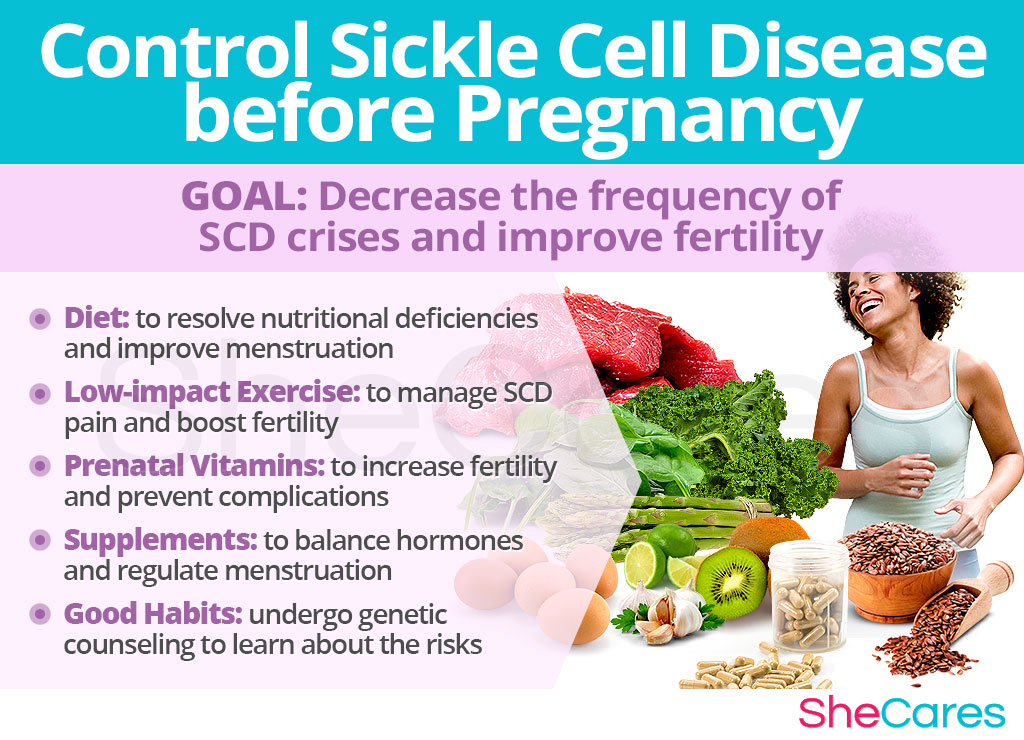
Tips for Conceiving with Sickle Cell Disease
As you attempt to get pregnant, it is a good idea to think of all the ways to help you be prepared in the case of a sudden flare-up of your condition.
Focus on omega-3 and protein-rich foods, such as salmon, walnuts, flax, or eggs, to boost your fertility.
Create a strong network of family and friends to lean on during conception and pregnancy.
Consider therapy if prolonged stress and anxiety are an issue. Mindfulness or art therapy have been shown helpful in preventing sickle cell disease symptoms.
Try to maintain stable body temperature as its rapid changes might result in sudden flare-ups.
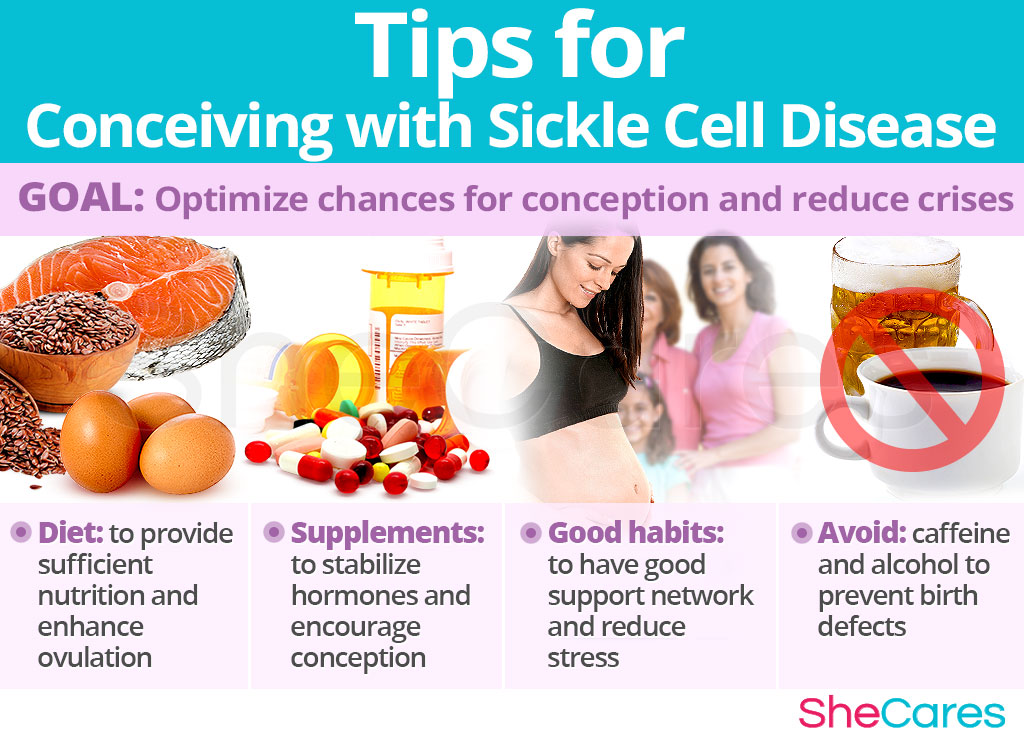
Manage Sickle Cell Disease during Pregnancy
Not all women experience a worsening of their condition during pregnancy, but having had created an action plan prior to conceiving will now give you a peace of mind that you have the means to face the crisis, if it occurs.
Maintain frequent doctor's check-ups to address any new symptoms before they lead to complications.
Your doctor might put you on low-dose aspirin to lower the risk of developing preeclampsia.
It is important to remember that sickle cell anemia in pregnancy cannot be improved merely by taking iron supplements, and it often requires transfusion.
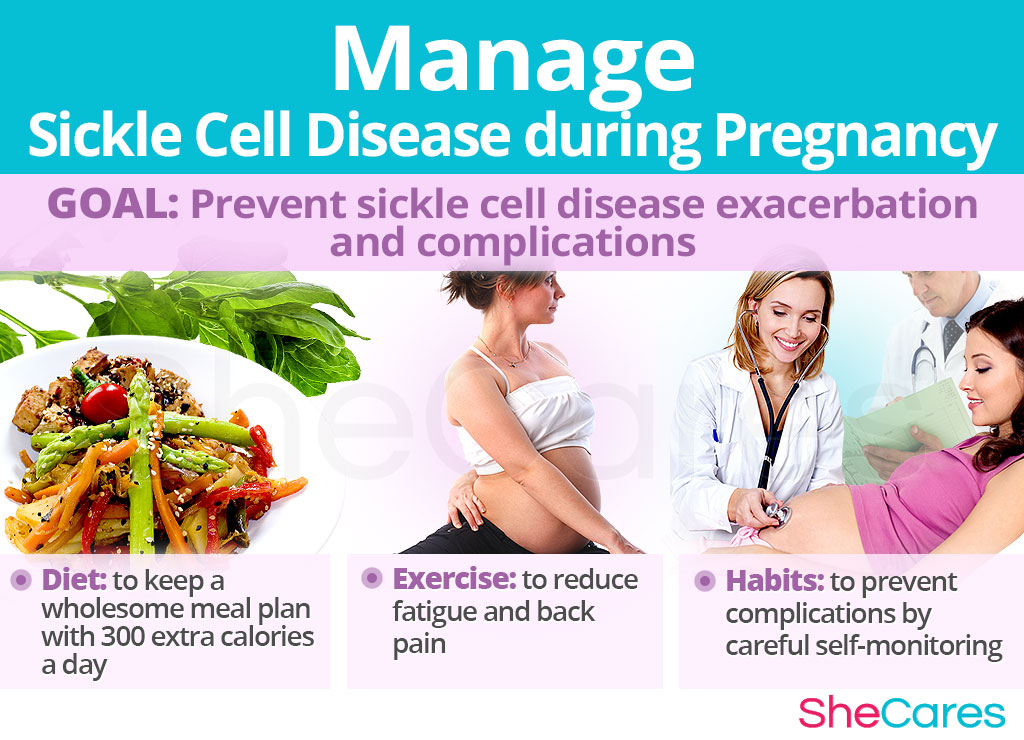
Key Takeaways
It is clear that sickle cell disease in pregnancy is a challenge both for women and their doctors, but it does not have to be an inhibiting factor. Most women SCD have manageable pregnancies and healthy babies, which can be achieved through diligent monitoring, proper diet, and supplements, like Macafem. Thanks to the advances in medicine, SCD females enjoy an improved life expectancy and can fulfill their maternal needs as well as other women.
Sources
- CDC. (n.d.). Sickle Cell Disease and Pregnancy. Retrieved November 21, 2017 from https://www.cdc.gov/ncbddd/sicklecell/pregnancy.html
- Maternal and Child Health Journal. (2013). Sickle Cell Disease in Pregnancy: Maternal Complications in a Medicaid-Enrolled Population. Retrieved November 21, 2017 from https://www.ncbi.nlm.nih.gov/pmc/articles/PMC4394367/
- March of Dimes. (2013). Sickle cell disease and pregnancy. Retrieved November 21, 2017 from https://www.marchofdimes.org/complications/sickle-cell-disease-and-pregnancy.aspx
- Missouri Department of Health and Senior Services. (n.d.). Sickle Cell Anemia. Retrieved November 21, 2017 from http://health.mo.gov/living/families/genetics/sicklecell/faqs.php
- Northwestern University. (2014). Sickle Cell Anemia. Retrieved November 21, 2017 from http://oncofertility.northwestern.edu/resources/sickle-cell-anemia
- Obstetrics and Gynecology International. (2016). Pregnancy in Sickle Cell Disease Is a Very High-Risky Situation: An Observational Study. Retrieved November 21, 2017 from https://www.ncbi.nlm.nih.gov/pmc/articles/PMC4926018/
- Royal College of Obstetricians & Gynecologists. (n.d.). Management of Sickle Cell Disease in Pregnancy. Retrieved November 21, 2017 from https://www.rcog.org.uk/globalassets/documents/guidelines/gtg_61.pdf
- The American Society of Hematology. (2014). Reproductive issues in sickle cell disease. Retrieved November 21, 2017 from https://www.ncbi.nlm.nih.gov/pubmed/25472967
- The Journals of Pain. (2012). A retrospective review of acupuncture use for the treatment of pain in sickle cell disease patients: a single institution analysis. Retrieved November 21, 2017 from http://www.jpain.org/article/S1526-5900(12)00058-2/abstract
- University College London Hospitals. (2015). Sickle cell disease and pregnancy. Retrieved November 21, 2017 https://www.uclh.nhs.uk/PandV/PIL/Patient%20information%20leaflets/Sickle%20cell%20disease%20and%20pregnancy.pdf
- University of Rochester Medical Center. (n.d.). Sickle Cell Disease and Pregnancy. Retrieved November 21, 2017 from https://www.urmc.rochester.edu/encyclopedia/content.aspx?ContentTypeID=90&ContentID=P02499
